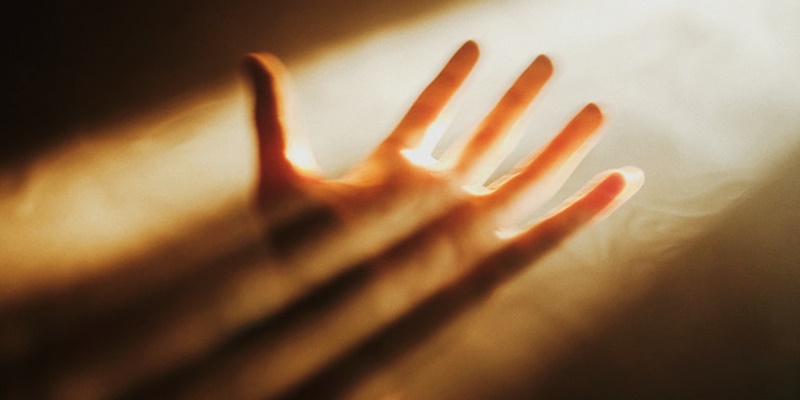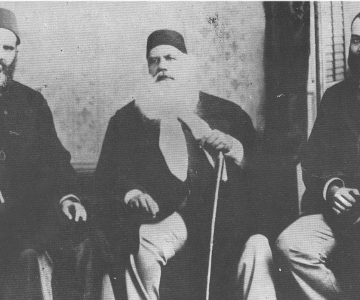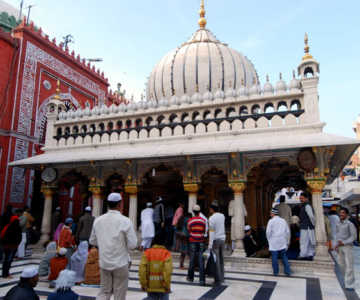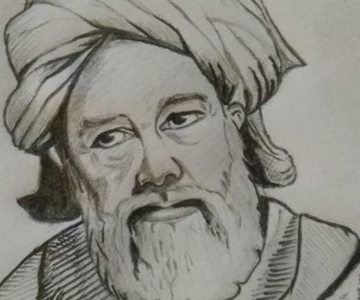Indian Muslims Blog is now two years old. The IM team have compiled the best articles published at the blog in 2007. Shameless as it sounds, one of my guest articles – Journeying into Mysticism is included in the category. As the editor Mohib, said the “colorful downloadable pdf file is worth reading for the diversity of views and opinions. IM blog team has been most kind to allow me to occasionally contribute to the space. In the process I have learnt a lot about the country and its Muslim population. But most importantly, I have found a few good friends from Lucknow, Kakori, Bhopal, and Bihar among other places. wah wah, kiya kehnay blogosphere ke…
To blow my own little trumpet in this seamless and infinite blogosphere, here is my piece for those readers who may not have read it earlier.
Journeying into mysticism
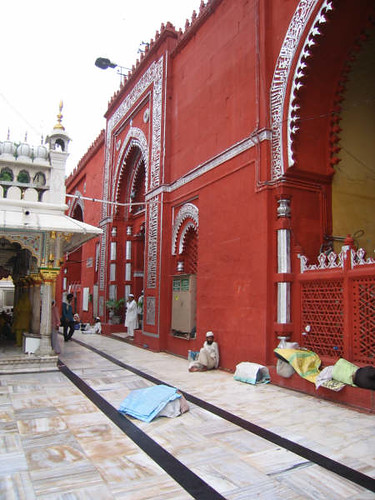
I turn my face towards the monsoon breeze and lament that I’m in Delhi for work. How will I manage the sightseeing agenda? The faint scent of champa flowers seems hauntingly familiar and I am reminded of Lahore. Despite my efforts, visa hassles and my non-Indo-Pak-peace-brigade status have prevented this journey from materialising for years. Driving through Delhi at night, I almost start the litany of superficial judgments but stop for fear of falling into the abyss of cliches. Nevertheless, I cannot help but notice the images of exotic India, or the official Incredible India. Yes, incredible is the word.
The Maurya Sheraton hotel is a haven of comfort totally removed from the real Delhi world. This is what I resent about luxury hotels in developing countries: the sense of disconnectedness, the ultimate denial of what lies beneath. Maurya is packed with party-hoppers as there is a huge weekend bash at the hotel. The Delhi party-goers are far more free-spirited than the Pakistani lot. They appear at ease with what they wear and do, and conduct themselves in a remarkably unselfconscious manner. The hotel driver, Uttam Ram, warned me that the ‘real’ India is different, that this crowd is too Westernised and the influence of Bollywood is to be blamed. . . but how can I agree? I live on Bollywood myself. The journey has been too long and that first night in Delhi, I crash on the huge four-poster bed. I am not a party boy after all!
Sunday morning passes in work – yes, I work on Sundays and have often thought of killing myself for accepting such terms in my mortal life. After an afternoon nap, I wake up to a sense of regret for having wasted a day in Dilli. I get in touch with Sadia Dehalvi, hoping for her company during my visit to Nizamuddin Auliya’s tomb. She is already planning to go there and we plan to meet a little before sunset.
I reach Mathura Road in an hour and soon find myself wading through its distinctly medieval ambience: labyrinthine alleys, crowds of beggars and street-vendors, a bazaar mood. To my delight, I spot a sign pointing towards Ghalib’s mazaar . This is a traditionally Muslim area: there are several signs offering Umra packages and most signs are in Urdu. The stereotype of suffering Indian Muslims gains currency here. I try not to notice all that and walk around until I find Ghalib’s mazaar . Having being fixated on Ghalib and his poetry for the better part of my life, I am a little disappointed by the matter-of-factness of the place. Even though the tomb has recently been renovated after a court order, it is quite low-key. Nevertheless, the area retains a unique atmosphere and the building itself is somewhat alluring. Near it is the Ghalib Academy, but I rush to Nizamuddin’s dargah and follow the scent of desi roses until I find my way to the tomb.
As I wait for Sadia, I muse about her varied talents, from photography to acting, music to publishing. Khushwant Singh devoted a book to her, announcing that she has earned much notoriety for him, but it might be the other way round since Sadia also appears in Singh’s infamous Men and women in my life . We share the gateway to Islam, since our respective families were converted by Hazrat Shamsuddin of Multan while our ancestors travelled to perform Hindu rites. Sadia is a scion of the Dehlvi khandaan , publishers of Shama , an Urdu language monthly that achieved great popularity even in Pakistan. Shama was closed some time ago and the majestic Dehlvi house was sold to a popular party representing the interests of scheduled castes in the United Provinces, but the Dehalvis retain their verve and sense of humour. The miniscule Muslim intelligentsia has integrated well in a rapidly changing India.
Sadia and I meet outside Nizamuddin’s tomb, where a qawali is being performed in the courtyard and hundreds of people of all faiths are present. While I imbibe this dramatic setting, Sadia introduces me to the local sajjada nasheen. Sadia and her family are life long devotees and know everyone there. I am ushered into the tomb and follow the motions: there is extended duaa and I am presented with a chaddar (in fact the chaddar is tied around my head, to the envy of many other visitors). Here, one can sense a truly profound mood, perhaps because the interior is so quiet, despite the human traffic.
I am curious to find out about Amir Khusrau’s tomb, Nizamuddin’s most prominent devotee who lies buried in the same compound. What a place this must have been, given the deep effect it had on language, multicultural and interfaith communication and the evolution of north Indian musicology. I’m suddenly overwhelmed by this place’s history and all that I have read on this particular era.
Princess Jehan Ara, Shah Jehan’s daughter and Dara Shikoh’s confidante, is also buried in the same compound. Her tomb is a small, elegant chamber made of polished white marble with delicately carved latticework. The epitaph is exciting indeed: Let naught but green grass cover my grave / For mortals poor it’s a grave-cover brave . Jehan Ara was a poet herself and has several diwans to her credit. Like Dara Shikoh, Jehan Ara’s character encompassed a deep strain of mysticism, a passionate and abiding love for the Chishti saints of India, especially Khwaja Moinuddin of Ajmer, whose tomb she expanded and biography she authored. Like Shah Jehan, she created many gardens and buildings. Delhi’s Chandni chowk was her brainchild. Jehan Ara and Dara were both losers in the grand battle between orthodoxy and syncretic Indo-Muslim culture. The struggle is not over, I remind myself. Lahore again intrudes on my thoughts: these royal children were inspired by Lahore’s Sufi saint Mian Mir . . . dear old locality of Mian Mir and the canal with those stunning jacaranda trees.
Recently, the French archaeologist/novelist Lyane Guillaume re-launched princess Jehan Ara in India and the West through the novel Jahanara . There has been some controversy about the historical narration since the novel is nuanced with incestuous references to the affinity between Jehan Ara and Shah Jehan on the one hand and the latter’s love for a female domestic attendant on the other. Guillaume might have been carried away a little whilst applying the Electra complex and modern theories regarding human sexuality to the Mughal royals; but then, the Mughals were no regular types either!
Sadia interrupts my musings and her 12-year old son Arman, Â who is a veritable musical genius, asks me several questions about his brothers in Karachi who are my dear friends. Sadia cracks a joke about Mohammad Shah Rangeela, who got a place for his tomb in the Nizamuddin sanctuary mainly because he was emperor until Nadir Shah looted Delhi. His tomb is desolate and not a single candle burns there. We then move to Pir Hasnain, who offers us masala chips and a much needed cup of tea. Being Pakistani, I am the recipient of some attention from the visitors at his gaddi . I get a sense of what is likely to come – my exotic Pakistani identity, questions on Musharraf, jihad, burqas and the Bollywood stereotype regarding Muslims. I pander to this discourse as far as possible until I can take it no more, reminding myself that Pakistani textbook representations of the wily, untrustworthy Hindu are mirror images of this syndrome.
Qawali resumes after Maghrib prayers and the place echoes with lyrics reminding me of dil-e-deewana-i-Khusrau . Eminent filmmaker Muzaffar Ali has turned Jashn-i-Khusrau into an international Sufi music event, and a few days later, Sadia makes me buy all the Jashn CDs, though I need little enough encouragement. I’ve immersed myself in the adulation of Khusrau since I became familiar with Urdu and Persian poetry; his contribution to the evolution of Urdu and modern Hindustani is still under-acknowledged. He was truly avant-garde, using modern idiom and imagery in medieval India. Later at home, Arman sings for us: Jiss sawan mein piya ghar naheen / Aag lagay uss sawan ko . A star in the making, he will graduate in music at the age of fourteen. I tell Sadia to do an anti- nazar totem to ward off the evil eye and we share a laugh, but not at the ludicrousness of the idea because she will do it!
In a while, we all are devouring Al-Kausar (a posh dhaaba ) karoli kebabs under a pipal (poplar) tree. Pipal trees are readily turned into pooja sites but this one has been spared – perhaps too much meat is consumed around here another problem for the RSS but then, India belongs to all Indians.
A few days later, I tell my workmate of the 22 khawajas buried under Delhi’s soil and the very central role this place has performed in the growth of Sufism in South Asia. My colleague is a little nonplussed as I hold forth, declaring that Delhi is a grand Muslim resource centre. By now, I have made an early morning dash to the Lodhi gardens and walked around the Humayun’s enchanting tomb. My fascination with the saints has not ended and on Thursday I find myself at the dargah of Khawaja Qutbuddin Bakhtiyar Kaki. Aibak was a mureed (disciple) of the saint Khawaja, after whom he named the Qutub Minar. Quite appropriately, the dargah is next to Qutub Minar in the quintessentially medieval Mehrouli area. Bahadur Shah Zafar also built a new residential palace here.
Khawaja Kaki is the Qutub-ul-Aqtaab or Qutub of all Qutubs. He mentored both Baba Fariduddin Ganjshakar of Pakpattan and Nizamuddin Auliya and therefore, has a central status in the Chishtiya line of sufism . His dargah is patently more sombre than Nizamuddin’s, with heavy air frozen in time. The rare treat is the unchanged architectural character – the alleys, tombs and arches are all reminiscent of the Sultanate or early Mughal style. The mazaar compound has four banyan trees at each corner of the square and the mazaar is protected by just a canopy standing on marble pillars. The pre- Maghrib dua was read in Persian, not Arabic “He is the leader of the saints and servant of the poor.” Simply astounding! In Pakistan, Khuda Hafiz has been thrown out by PTV and Ziaist mores. It has been almost twenty years since the heyday of the piety-driven cultural purge in the dear homeland.
We sit for some time in a medieval hujra to eat the langar daal and rotees . According to popular lore, Khwaja’s miracle was the creation of kakis or small baked pieces of bread that he could cobble from nothingness. My companions, the Dehalvis, are frequent visitors and have renovated a hujra that was occupied by a devotee of the Khawaja. We say the farewell salaam and the shrine manager enters like a king, repeating the age-old practice of local royalty bowing before the Sufis with people’s power. We walk towards the Qutub Minar and I find the place, the mood and ambience quite delightful. Noting the locale, several Delhi designers and artists have bought property in the area and a popular, chic Italian restaurant is also located here.
The next destination is old Delhi. Eating at Kareem’s opposite the Jamia Masjid is essential to a visit here. There is an old Lahore feel to the place except that the Urdu is being spoken in several dialects. I pick up some accents but the others remain elusive. Sarmad the naked faqir is buried close by, killed on Aurangzeb’s orders for declaring his Hallajesque identification with divine reality. Other than his refusal to wear clothes, he was brazenly anti-orthodoxy and made no bones about his love for the Hindu (male) beloved who made him a deewana in the first place. Above all, he was revered by the eccentric Dara Shikoh. How can we blame the righteous Aurangzeb for the judicial murder? There was apparently a trial of sorts, but dissent has always been an endangered species in our part of the world.
I think of Dara Shikoh again but refrain from crafting postulates. Aurangzeb was the victor and sadly, that’s that. Years ago, an internationally acclaimed bureaucrat turned ‘intellectual’, compared the Bhutto-Zia conflict with the Dara-Aurangzeb struggle in a paper that apparently got him a favourable posting. In 2005, Mulayam Singh Yadav wants to appease his UP voters by siding with the misogynist fatwas of the local maulvis. Pandering to extremism for self interest has been perfected to an art form in India and Pakistan. But the bhakats , the kabeers and the Sufis are still around, and I am relieved to remember this. There is still light at the end of the tunnel. It was on this thought that I left Old Delhi.
An earlier version of this article appeared in the Friday Times, Pakistan
